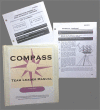The COMmunity of Practice And Safety Support (COMPASS) Total Worker Health™ study among home care workers: study protocol for a randomized controlled trial
- PMID: 25348013
- PMCID: PMC4226848
- DOI: 10.1186/1745-6215-15-411
The COMmunity of Practice And Safety Support (COMPASS) Total Worker Health™ study among home care workers: study protocol for a randomized controlled trial
Abstract
Background: Home care workers are a high-risk group for injury and illness. Their unique work structure presents challenges to delivering a program to enhance their health and safety. No randomized controlled trials have assessed the impact of a Total Worker Health™ program designed for their needs.
Methods/design: The COMPASS (COMmunity of Practice And Safety Support) study is a cluster randomized trial being implemented among Oregon's unionized home care workers. Partnering with the Oregon Home Care Commission allowed recruiting 10 pairs of home care worker groups with 8 participants per group (n = 160) for balanced randomization of groups to intervention and control conditions. Physiologic and survey evaluation of all participants will be at enrollment, 6 months and 12 months. Primary outcomes are to increase health promoting (for example, healthy nutrition and regular physical activity) and health protecting (that is, safety) behaviors. In addition to assessing outcomes adjusted for the hierarchical design, mediation analyses will be used to deconstruct and confirm the program's theoretical underpinnings and intervention processes. Intervention groups will participate in a series of monthly 2-hour meetings designed as ritualized, scripted peer-led sessions to increase knowledge, practice skills and build support for healthy actions. Self-monitoring and individual and team level goals are included to augment change. Because generalizability, reach and achieving dissemination are priorities, following initial wave findings, a second wave of COMPASS groups will be recruited and enrolled with tailoring of the program to align with existing Home Care Commission educational offerings. Outcomes, process and mediation of those tailored groups will be compared with the original wave's findings.
Discussion: The COMPASS trial will assess a novel program to enhance the safety and health of a vulnerable, rapidly expanding group of isolated caregivers, whose critical work allows independent living of frail seniors and the disabled.
Trial registration: ClinicalTrials.gov identifier: NCT02113371, first registered 11 March 2014.
Figures
References
-
- Hymel PA, Loeppke RR, Baase CM, Burton WN, Hartenbaum NP, Hudson TW, McLellan RK, Mueller KL, Roberts MA, Yarborough CM, Konicki DL, Larson PW. Workplace health protection and promotion: a new pathway for a healthier-and safer-workforce. J Occup Environ Med. 2011;53:695–702. doi: 10.1097/JOM.0b013e31822005d0. - DOI - PubMed
-
- Bureau of Labor Statistics, U.S. Department of Labor: Occupational Outlook Handbook. 2014–2015 edition. Available at http://www.bls.gov/ooh/. Accessed May 2014.
-
- Gershon RRM, Pogorselska M, Qureshi KA, Stone PW, Canton AN, Samar SM, Westra LJ, Damsky MR, Sherman M. Home health care patients and safety hazards in the home: preliminary findings. In: Henrcksen K, Battles JB, Keyes MA, Grady ML, editors. Advances in Patient Safety: New Directions and Alternative Approaches, Assessment. 1. Rockville, MD: Agency for Health Care Research and Quality; 2008. - PubMed
Publication types
MeSH terms
Associated data
Grants and funding
LinkOut - more resources
Full Text Sources
Other Literature Sources
Medical




